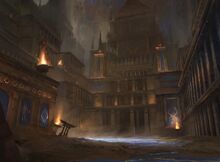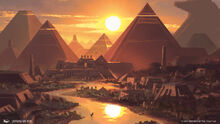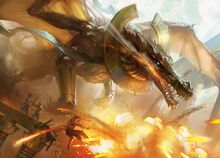"We erupt from peaks of chaos and flow from rivers of molten rage. We are power and the will to use it. If you fear our fire, you are unworthy of it." -Konahrik

Rule[]
Titled Ruler: First Dragons
Governance: Tyrannic Despotism
Law: Barbarism
Economy: Slavery

Census[]
Lands: Athas, Najara
Cities: Lo'vanthor, City of the Dragon God (Capitol)
Common Folk: Dragons
Vassal Folk: Dray, Kobold, Ssurran, Yuan Ti
Geography[]
Life hung by a thread in this barren land beneath a crimson sun. Wastelands of majestic desolation and cities of cruel splendor - Athas, a dying land of savagery and desolation. Athas was a hot, arid land covered with endless seas of dunes, lifeless salt flats, stony wastes, rocky bad lands, thorny scrublands, and worse. From the first moments of dawn, the crimson sun beat down from an olive tinged sky. Temperatures routinely exceeded one hundred degrees by midmorning, and could reach one hundred thirty degrees or more by late afternoon. The wind was like the blast of a furnace, offering no relief from the oppressive heat. Dust and sand borne on the breeze coated everything with yellow-orange silt.

In this forbidding realm, cities and villages existed only in a few oases or verdant plains. Some places didn’t see rain for years at a time, and even in fertile regions, rain was little more than a humid mist that fell during a few weeks each year before giving way to long months of heat and drought. The land beyond these islands of civilization was a wasteland roamed by nomads, raiders, and hungry monsters. Athas was not always a desert, and the parched landscape was dotted with the crumbling ruins of a realm that once was rich with rivers and seas. Ancient bridges over dry watercourses and empty stone quays that face seas of sand told the tale of a world that was no more.
Life in Athas was brutal and short. Bloodthirsty raiders, greedy slavers, and hordes of barbarians and savages overran the deserts and wastelands. The cities were little better, for they choked in the grips of ageless tyrants. The institution of slavery was widespread in Athas, and many unfortunates spent their lives in chains, toiling for brutal taskmasters. Every year hundreds of slaves, perhaps thousands, were sent to their deaths in bloody arena spectacles. Charity, compassion, kindness - these qualities existed, but they were rare and precious. Only a fool hoped for such riches.
Most arms and armor were made of bone, stone, wood, and other such materials. Mail or plate armor existed only in the treasuries of the dragon lords. Steel blades were almost priceless, weapons that many never saw during their lifetimes. Terrible defilers of immense power ruled the city-states. These mighty spellcasters had held their thrones for centuries; no one remembered a time before the sorcerer kings. Some claimed to serve gods, and some claimed to be gods. Some were brutal oppressors, where others were more subtle in their tyranny. The sorcerer-kings governed through greedy wyrmpriests or ambitious templars, lesser defilers who could call upon the kings’ powers.

The desert realm had its own deadly ecology. Athas had no cattle, swine, or horses; instead, people tended flocks of erdlus, rided on kanks or crodlus, and drew wagons with mixes and mekillots. Wild creatures such as lions, bears, and wolves were nonexistent. In their place were terrors such as the id fiend, the baazrag, and the tembo. Perhaps the harsh environment of Athas bred creatures tough and vicious enough to survive it, or maybe the touch of ancient sorcery poisoned the wellsprings of life and inflicted monster after monster on the dying land. Either way, the deserts were perilous, and only a fool or a lunatic traveled them alone.
In Athas, there was no source for arcane magic, and thus, spellcasters drew mana for their spells from life. Defilers abused this energy, causing life around them to wither and turn to ash, destroying it forever and tainting the surrounding landscape for decades. Spellcasters with more self control who did not wish harm upon Athas' already dwindling lives were called preservers. They were able to channel the mana in such a way that caused negligible harm to the environment. To the average Athasian, however, there was no difference. All spellcasters were evil, and it was because of them that the realm was the desolate wasteland it was under Arkhosia.

History[]
Culturally, the Empire of Arkhosia was very different from the Empire of Bael Turath, being much more ecumenically-driven than its counterpart. The Arkhosian Empire was hierarchical, utilizing both a rigid caste system and a stratified rank structure to put its subjects in their proper place. Due to how long Arkhosian society had separated the thrall races into castes, each caste was sometimes referred to as a sub-species of dragon. The Bozak Draconian were the priest caste of the Dragonborn who also served as spiritual leaders that indoctrinated others into Arkhosian teachings. This was also where the masters and students of the Ninefold Path were placed.
In contrast, the Kopak Draconian were the warrior caste of the Dragonborn. They were unquestioningly obedient to the First Dragons of Arkhosia; they were also loyal to the individual Dragon Lord they served, though this loyalty was secondary to their loyalty to Bahamut and Tiamat. The Kobold caste, who worshiped the dragons as gods, built and maintained Arkhosian engineering, including their war machines and ships. Ssurran slaves were the lowliest caste of the Arkhosian Empire. Often used as blood sacrifices, the slaves served in menial tasks, such as grooming a Dragon's claws. Most of the Empire lived in this caste-driven structure, in which they toiled to build their rulers' tombs or died by the thousands in internecine warfare. They were ultimately ruled by a militaristic culture with a great reverence for the dead. When a Dragon Lord died, his slaves were buried alive with his body in his tomb.

When Bahamut unified the Dragons, he took the title of 'Dovahdrog,' meaning 'Dragon Lord' in common. They were the leaders of the Arkhosian Empire. Each Dragon Lord had his own slaves and his own horde while Bahamut and Tiamat ruled over all the Dragon Lords. Following the formation of the Arkhosian Empire, many claimed the title of Dragon Lord and fought each other in constant civil wars, each ruling only a fief. Following the fall of the Arkhosian Empire, the word 'Dovahdrog' took on the approximate meaning 'Champion of Prophecy,' referring to an unidentified individual who would fulfill the Draconic Prophecy.
The term 'Krojun' was the title translated 'Sorcerer King' in common. Sorcerer Kings were the greatest and most powerful of the Dragon Lords. The original Sorcerer Kings were Bahamut and Tiamat's inner circle; later Sorcerer Kings were Dragon Lords who assumed the title after the death of the previous Sorcerer King, defeating any rival claimant to the title in combat. Through the first and second eras, Bahamut and Tiamat collectively ruled the Empire through the Sorcerer Kings; each Sorcerer King led many Dragon Lords.

Before the formation of the Arkhosian Empire, the dragons were engaged in constant warfare with one another, though this was seen as an acceptable practice, as they believed it to be a fundamental aspect of their existence. This meant that they lived both a barbaric yet strangely harmonious existence in Athas. The early dragons often engaged in blood sacrifices which they made to their god Io. Their constant warring led to a dwindling of the population in Athas, as well as cultivated an intensely hostile society. After the formation of the Arkhosian Empire, only those who wielded terrible power had the capacity to reach the upper echelons of the Empire. Those that failed to accumulate arcane secrets, divine favor, or psionic power, were considered worthless. Among the elite, power was craved due to the intense greed perpetuated by Tiamat, which also meant that they were ambitious as well as paranoid. This society encouraged the survival of the fittest with only the most ruthless and powerful surviving, let alone rising to positions of power.
The Arkhosian Empire ultimately thrived on slavery, as well as the exploitation and oppression of the masses. In addition, they lived in constant belief that they would face external threats to their dominion and thus had a belief in expansion or dying. Some believed that this was a necessity for the dragons as they hungered for new lands and riches to bring under their control. This allowed for Sorcerer King Hofkah to lead his forces during the first invasion. Even so, there were other, traditional and more conservative factions, that believed in remaining within their territory in order to preserve their ways.

During the time of the Arkhosian Empire, there were many instances of explorers stumbling into Arkhosian land, where they became slaves to one of the many Dragon Lords. Over the years of enslavement, these outsiders continued to live for generations, forgetting their origins, and becoming true thralls of the dragons. Some Dragon Lords even found value in the descendants of these outsiders, such as the wizards, due to their arcane secrets. Dragon Lords tended to focus on sorcery, while the wizards' excellence in the formal study of arcana meant that they became valued treasures of their owning Dragon Lords. Through such means as presented by the wizards, the dragons developed the Ninefold Path. However, the intense rivalry and fierce competitive nature of Arkhosian society meant that Dragon Lords never shared these treasures. Among the dragons, glorification of self and the subjugation of others was a central tenant of their society.
One of the greatest treasures of the dragons was their devotion to the arts of draconic sorcery. As such, individuals that practiced this art took on the title of Dragonsoul Heirs. This art was practiced by dragons who often dwelt in temple-palaces where they studied in meditation, and recorded their experiences and experiments. They created many tools to enhance or project their power, which was commonly seen in dragon talismans. These dragon magic constructs were capable of a wide range of feats, from being simple arcane concentration tools, to divine warding, or even psionic enthralling. They also created special temples and lairs that amplified their powers. The dragons were also quite skilled in the art of alchemy, though it was the wizards who later perfected the study. Originally, the dragons were a united people who preferred to stay within separate and divided tribes. This remained the case until the formation of the Arkhosian Empire at Lo'vanthor, City of the Dragon God.